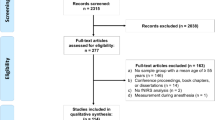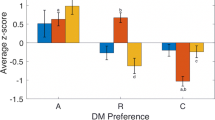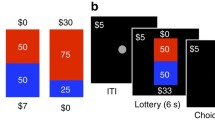Abstract
Few research publications have reported on gender-dependent neural correlates of risk decision-making in older adults. In this study, we utilized functional near-infrared spectroscopy (fNIRS) to comprehensively investigate both age- and gender-dependent differences in neural correlates in response to a well-utilized risk decision-making protocol, the Balloon Analog Risk Task (BART). A newly-developed technique, atlas-guided diffuse optical tomography (atlas-DOT), was used to image the prefrontal cortices (PFC) of healthy subjects in two age groups (25–40 years; 60–92 years) using BART stimulation. The behavioral measures and brain activations imaged by atlas-DOT were recorded and compared for both age groups. Three-factor analysis of variance was conducted to include all effects of age (young, old), gender (male, female), case (win, lose) and their interactions for both behavioral and hemodynamic responses. The results indicated age differences in cortical activation patterns, activation amplitudes, and brain-behavior correlations. Larger areas of cortical activation with reduced amplitudes in the PFC were observed in older adults when they performed BART. Brain-behavior correlations indicated that young adults took more risks, whereas older adults were more risk-averse. Results also revealed a gender effect in young adults, but not in older adults. Both male and female older adults demonstrated strong PFC responses and the same risk-averse patterns under lose outcomes. This is the first study to examine the neural correlates of risk decisions in older adults by optical brain imaging.









Similar content being viewed by others
References
Aklin, W. M., Lejuez, C. W., Zvolensky, M. J., Kahler, C. W. & Gwadz, M. (2005) Evaluation of behavioral measures of risk taking propensity with inner city adolescents. Behaviour Research and Therapy, 43(2), pp. 215–228.
Benjamini, Y., Drai, D., Elmer, G., Kafkafi, N. & Golani, I. (2001) Controlling the false discovery rate in behavior genetics research, Behavioural Brain Research, 125(1-2), pp. 279–284.
Boas, D. A. & Dale, A. M. (2005) Simulation study of magnetic resonance imaging-guided cortically constrained diffuse optical tomography of human brain function, Applied Optics, 44(10), pp. 1957–1968.
Burgess, P. W., Dumontheil, I., & Gilbert, S. J. (2007). The gateway hypothesis of rostral prefrontal cortex (area 10) function. Trends in Cognitive Sciences, 11(7), 290–298.
Cabeza, R. (2001) Cognitive neuroscience of aging: Contributions of functional neuroimaging. Scandinavian Journal of Psychology, 42(3), pp. 277–286.
Cabeza, R., Daselaar, S. M., Dolcos, F., Prince, S. E., Budde, M., & Nyberg, L. (2004). Task-independent and task-specific age effects on brain activity during working memory, Visual attention and episodic retrieval. Cerebral Cortex, 14(4), 364–375.
Carstensen, L. L., Hartel, C. R. & Mather, M. (2006) A Review of Decision-Making Processes: Weighing the Risks and Benefits of Aging.
Cazzell, M., Li, L., Lin, Z. J., Patel, S. J., & Liu, H. (2012). Comparison of neural correlates of risk decision making between genders: An exploratory fNIRS study of the balloon analogue risk task (BART). NeuroImage, 62(3), 1896–1911.
Coffey, C. E., Lucke, J. F., Saxton, J. A., Ratcliff, G., Unitas, L. J., Billig, B., & Bryan, R. N. (1998). Sex differences in brain aging: a quantitative magnetic resonance imaging study. Archives of Neurology, 55(2), 169–179.
Crowley, T. J., Raymond, K. M., Mikulich-Gilbertson, S. K., Thompson, L. L. & Lejuez, C. W. (2006) A risk-taking “set” in a novel task among adolescents with serious conduct and substance problems. Journal of the American Academy of Child and Adolescent Psychiatry, 45(2), pp. 175–183.
Cui, X., Bray, S., Bryant, D. M., Glover, G. H. & Reiss, A. L. (2011) A quantitative comparison of NIRS and fMRI across multiple cognitive tasks. NeuroImage, 54(4), pp. 2808–2821.
Deakin, J., Aitken, M., Robbins, T., & Sahakian, B. J. (2004). Risk taking during decision-making in normal volunteers changes with age. Journal of the International Neuropsychological Society, 10(4), 590–598.
Dehghani, H., Eames, M. E., Yalavarthy, P. K., Davis, S. C., Srinivasan, S., Carpenter, C. M., Pogue, B. W., & Paulsen, K. D. (2008). Near infrared optical tomography using NIRFAST: Algorithm for numerical model and image reconstruction. Communications in Numerical Methods in Engineering, 25(6), 711–732.
Dong, G., Lin, X., Zhou, H., & Du, X. (2014). Decision-making after continuous wins or losses in a randomized guessing task: Implications for how the prior selection results affect subsequent decision-making. Behavioral and Brain Functions, 10, 11.
Elliott, R. (2003). Executive functions and their disorders. British Medical Bulletin, 65, 49–59.
Eppinger, B., Nystrom, L. E., & Cohen, J. D. (2012). Reduced sensitivity to immediate reward during decision-making in older than younger adults. PloS One, 7(5) p. e36953.
Ernst, M., Bolla, K., Mouratidis, M., Contoreggi, C., Matochik, J. A., Kurian, V., Cadet, J. L., Kimes, A. S., & London, E. D. (2002). Decision-making in a risk-taking task: a PET study. Neuropsychopharmacology, 26(5), 682–691.
Eyler, L. T., Sherzai, A., Kaup, A. R., & Jeste, D. V. (2011). A review of functional brain imaging correlates of successful cognitive aging. Biological Psychiatry, 70(2), 115–122.
Fellows, L. K. (2006). Deciding how to decide: Ventromedial frontal lobe damage affects information acquisition in multi-attribute decision making. Brain, 129(Pt 4), 944–952.
Fellows, L. K., & Farah, M. J. (2007). The role of ventromedial prefrontal cortex in decision making: Judgment under uncertainty or judgment per se? Cerebral Cortex, 17(11), 2669–2674.
Folley, B. S., & Park, S. (2005). ‘Verbal creativity and schizotypal personality in relation to prefrontal hemispheric laterality: a behavioral and near-infrared optical imaging study’. Schizophrenia Research, 80(2–3), 271–282.
Franceschini, M. A., & Boas, D. A. (2004). Noninvasive measurement of neuronal activity with near-infrared optical imaging. NeuroImage, 21(1), 372–386.
Friedman, D. (2003). Cognition and aging: A highly selective overview of event-related potential (ERP) data. Journal of Clinical and Experimental Neuropsychology, 25(5), 702–720.
Galvan, A., Schonberg, T., Mumford, J., Kohno, M., Poldrack, R. A., & London, E. D. (2013). Greater risk sensitivity of dorsolateral prefrontal cortex in young smokers than in nonsmokers. Psychopharmacology, 229(2), 345–355.
Hansel, A. & von Kanel, R. (2008) ‘The ventro-medial prefrontal cortex: a major link between the autonomic nervous system, regulation of emotion, and stress reactivity?’, Biopsychosoc Med, 2, p. 21.
Harle, K. M., & Sanfey, A. G. (2012). Social economic decision-making across the lifespan: An fMRI investigation. Neuropsychologia,, 50(7), 1416–1424.
Harris, C. R., Jenkins, M., & Glaser, D. (2006). Gender differences in risk assessment: Why do women take fewer risks than men?. Judgment and Decision making, 1(1), 48–63.
Knoch, D., Gianotti, L. R., Pascual-Leone, A., Treyer, V., Regard, M., Hohmann, M., & Brugger, P. (2006). Disruption of right prefrontal cortex by low-frequency repetitive transcranial magnetic stimulation induces risk-taking behavior. The Journal of Neuroscience, 26(24), 6469–6472.
Koechlin, E., & Hyafil, A. (2007). Anterior prefrontal function and the limits of human decision-making. Science, 318(5850), 594–598.
Lee, T. M., Chan, C. C., Leung, A. W., Fox, P. T., & Gao, J. H. (2009). Sex-related differences in neural activity during risk taking: An fMRI study. Cerebral Cortex, 19(6), 1303–1312.
Lee, T. M., Leung, A. W., Fox, P. T., Gao, J. H., & Chan, C. C. (2008). Age-related differences in neural activities during risk taking as revealed by functional MRI. Social Cognitive and Affective Neuroscience, 3(1), 7–15.
Lejuez, C. W., Aklin, W., Bornovalova, M., & Moolchan, E. T. (2005). Differences in risk-taking propensity across inner-city adolescent ever- and never-smokers. Nicotine & Tobacco Research, 7(1), 71–79.
Lejuez, C. W., Read, J. P., Kahler, C. W., Richards, J. B., Ramsey, S. E., Stuart, G. L., Strong, D. R., & Brown, R. A. (2002). Evaluation of a behavioral measure of risk taking: the Balloon Analogue Risk Task (BART). Journal of Experimental Psychology. Applied, 8(2), 75–84.
Lighthall, N. R., Mather, M., & Gorlick, M. A. (2009). Acute stress increases sex differences in risk seeking in the balloon analogue risk task. PloS One, 4(7) e6002.
Lighthall, N. R., Sakaki, M., Vasunilashorn, S., Nga, L., Somayajula, S., Chen, E. Y., Samii, N., & Mather, M. (2012). Gender differences in reward-related decision processing under stress. Social Cognitive and Affective Neuroscience, 7(4), 476–484.
Lin, Z. J., Li, L., Cazzell, M., & Liu, H. (2014). Atlas-guided volumetric diffuse optical tomography enhanced by generalized linear model analysis to image risk decision-making responses in young adults. Human Brain Mapping, 35(8), 4249–4266.
Mak, A. K., Hu, Z. G., Zhang, J. X., Xiao, Z., & Lee, T. M. (2009). Sex-related differences in neural activity during emotion regulation. Neuropsychologia, 47(13), 2900–2908.
Marschner, A., Mell, T., Wartenburger, I., Villringer, A., Reischies, F. M., & Heekeren, H. R. (2005). Reward-based decision-making and aging. Brain Research Bulletin, 67(5), 382–390.
McCarrey, A. C., Henry, J. D., von Hippel, W., Weidemann, G., Sachdev, P. S., Wohl, M. J., & Williams, M. (2012). Age differences in neural activity during slot machine gambling: An fMRI study. PloS One, 7(11) e49787.
McRae, K., Ochsner, K. N., Mauss, I. B., Gabrieli, J. J. D., & Gross, J. J. (2008). Gender Differences in Emotion Regulation: An fMRI Study of Cognitive Reappraisal. Group Processes & Intergroup Relations,, 11(2), 143–162.
Mohr, P. N., Li, S. C., & Heekeren, H. R. (2010). Neuroeconomics and aging: neuromodulation of economic decision making in old age. Neuroscience and Biobehavioral Reviews, 34(5), 678–688.
Monti, M. M. (2011). Statistical Analysis of fMRI Time-Series: A critical review of the GLM approach. Frontiers in Human Neuroscience, 5, 28.
Nasreddine, Z. S., Phillips, N. A., Bedirian, V., Charbonneau, S., Whitehead, V., Collin, I., Cummings, J. L., & Chertkow, H. (2005). The Montreal Cognitive Assessment, MoCA: a brief screening tool for mild cognitive impairment. Journal of the American Geriatrics Society, 53(4), 695–699.
Niu, H., Tian, F., Lin, Z. J., & Liu, H. (2010). Development of a compensation algorithm for accurate depth localization in diffuse optical tomography. Optics Letters, 35(3), 429–431.
Pochon, J. B., Levy, R., Poline, J. B., Crozier, S., Lehericy, S., Pillon, B., Deweer, B., Le Bihan, D., & Dubois, B. (2001). The role of dorsolateral prefrontal cortex in the preparation of forthcoming actions: An fMRI study. Cerebral Cortex, 11(3), 260–266.
Powell, M., & Ansic, D. (1997). Gender differences in risk behaviour in financial decision-making: An experimental analysis. Journal of Economic Psychology, 18(6), 605–628.
Rao, H., Korczykowski, M., Pluta, J., Hoang, A., & Detre, J. A. (2008). Neural correlates of voluntary and involuntary risk taking in the human brain: An fMRI study of the balloon analog risk task (BART). NeuroImage, 42(2), 902–910.
Rogalsky, C., Vidal, C., Li, X., & Damasio, H. (2012). Risky decision-making in older adults without cognitive deficits: An fMRI study of VMPFC using the Iowa gambling task. Social Neuroscience, 7(2), 178–190.
Rosen, A. C., Prull, M. W., O’Hara, R., Race, E. A., Desmond, J. E., Glover, G. H., Yesavage, J. A. & Gabrieli, J. D. (2002) Variable effects of aging on frontal lobe contributions to memory. Neuroreport, 13(18), pp. 2425–2428.
Samanez-Larkin, G. R., & Knutson, B. (2015). Decision making in the ageing brain: Changes in affective and motivational circuits. Nature Reviews. Neuroscience, 16(5), 278–289.
Sowell, E. R., Peterson, B. S., Thompson, P. M., Welcome, S. E., Henkenius, A. L., & Toga, A. W. (2003). Mapping cortical change across the human life span. Nature Neuroscience, 6(3), 309–315.
Spreng, R. N., Wojtowicz, M., & Grady, C. L. (2010). Reliable differences in brain activity between young and old adults: A quantitative meta-analysis across multiple cognitive domains. Neuroscience and Biobehavioral Reviews, 34(8), 1178–1194.
Strangman, G., Culver, J. P., Thompson, J. H. & Boas, D. A. (2002) A quantitative comparison of simultaneous BOLD fMRI and NIRS recordings during functional brain activation. NeuroImage, 17(2), pp. 719–731.
Tanaka, S. C., Doya, K., Okada, G., Ueda, K., Okamoto, Y., & Yamawaki, S. (2004). Prediction of immediate and future rewards differentially recruits cortico-basal ganglia loops. Nature Neuroscience, 7(8), 887–893.
van den Bos, R., Homberg, J., & de Visser, L. (2013). A critical review of sex differences in decision-making tasks: Focus on the Iowa gambling task. Behavioural Brain Research, 238, 95–108.
Van Leijenhorst, L., Gunther Moor, B., Op de Macks, Z. A., Rombouts, S. A., Westenberg, P. M., & Crone, E. A. (2010). Adolescent risky decision-making: Neurocognitive development of reward and control regions. NeuroImage, 51(1), 345–355.
Wager, T. D., Phan, K. L., Liberzon, I., & Taylor, S. F. (2003). Valence, Gender, and lateralization of functional brain anatomy in emotion: a meta-analysis of findings from neuroimaging. NeuroImage, 19(3), 513–531.
Yurgelun-Todd, D. (2007) Emotional and cognitive changes during adolescence. Current Opinion in Neurobiology, 17(2), pp. 251–257.
Zhang, H., Duan, L., Zhang, Y. J., Lu, C. M., Liu, H., & Zhu, C. Z. (2011). Test-retest assessment of independent component analysis-derived resting-state functional connectivity based on functional near-infrared spectroscopy. NeuroImage, 55(2), 607–615.
Acknowledgments
The authors acknowledge the support in part from the 2012 Southern Nursing Research Society Research Award.
Author information
Authors and Affiliations
Corresponding author
Ethics declarations
Conflict of interest
All of the authors declare no conflict of interest.
Ethical approval
All procedures performed in studies involving human participants were in accordance with the ethical standards of the institutional and/or national research committee and with the 1964 Helsinki declaration and its later amendments or comparable ethical standards. This article does not contain any studies with animals performed by any of the authors. Informed consent was obtained from all individual participants included in the study.
Rights and permissions
About this article
Cite this article
Li, L., Cazzell, M., Zeng, L. et al. Are there gender differences in young vs. aging brains under risk decision-making? An optical brain imaging study . Brain Imaging and Behavior 11, 1085–1098 (2017). https://doi.org/10.1007/s11682-016-9580-z
Published:
Issue Date:
DOI: https://doi.org/10.1007/s11682-016-9580-z




